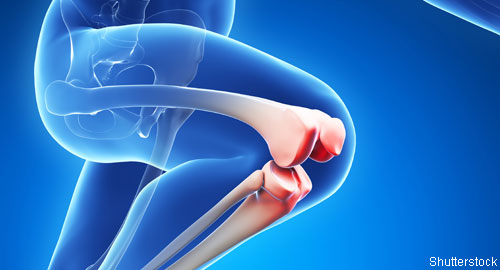 Specific joints must be able to withstand distinct types of biomechanical stress. Example: The articular cartilage of the hinged knee joint must be able to withstand a great deal of strain, while the ball and socket hip joint must resist shear stress. Cartilage supports these different functions via a matrix of discrete, but interacting, suprastructures that include cartilage fibers with microfibrillar or network-like aggregates, as well as a penetrating extrafibrillar proteoglycan matrix. The collagen fibers absorb tension, and the proteoglycan matrix absorbs compression. Now, recent research sheds light on collagen fiber biogenesis, function and homeostasis in hyaline cartilage. Such insight into the assembly process of composite fibril bundles should allow for an improved understanding of normal cartilage function, as well as cartilage development, remodeling and degeneration.
Specific joints must be able to withstand distinct types of biomechanical stress. Example: The articular cartilage of the hinged knee joint must be able to withstand a great deal of strain, while the ball and socket hip joint must resist shear stress. Cartilage supports these different functions via a matrix of discrete, but interacting, suprastructures that include cartilage fibers with microfibrillar or network-like aggregates, as well as a penetrating extrafibrillar proteoglycan matrix. The collagen fibers absorb tension, and the proteoglycan matrix absorbs compression. Now, recent research sheds light on collagen fiber biogenesis, function and homeostasis in hyaline cartilage. Such insight into the assembly process of composite fibril bundles should allow for an improved understanding of normal cartilage function, as well as cartilage development, remodeling and degeneration.
Riccardo Gottardi, PhD, a postdoctoral fellow at the University of Genova in Italy, and colleagues published the results of their study of fiber organization online on Oct. 25 in PLOS ONE. The investigators used scanning electron microscopy (SEM) to study fibrils within the cartilage. They focused their efforts on the suprastructural organization of collagen fibrils, as well as the degradation process of hierarchical organized fiber architecture. To achieve their high-resolution analysis, the investigators developed a protocol that allowed them to image collagenous cores of the fibers.
The researchers began by investigating the surface, middle and deeper zones of healthy human knee and hip articular cartilage. They found that the articular cartilages were permeated by small prototypic fibrils of a homogeneous diameter. The team also discovered that thick fibers were actually bundles of thin fibrils that had aligned in a D-periodic pattern and then merged via lateral association. The investigators describe the advantages of such a structure in their paper.
“We have documented that collagen fibers are organized like multi-thread ropes in which each thread corresponds to a prototypic sub-fibril,” write the authors. “Such multi-thread ropes are more flexible than compact fibers of the same diameter and, therefore, better suited for soft deformable materials or structures, such as articular cartilage. Furthermore larger fibrils present an increased safety against failure known in rope fiber industry as the Cook-Gordon effect, and describes that an occasional crack in a multi-thread cable is diverted and stopped at the surface of each thread and does not propagate through the whole diameter as it would in a single-thread rope.”
The researchers also reported that the organization of the fibers differed between the cartilages of distinct tissues. Example: In the superficial regions of the knee, the fibers appeared to twist like ropes. In contrast, in the deeper regions of the knee or hip joints, the fibers assembled into parallel-aligned, cable-like structures. These results not only provide insights into how different cartilage can resist different stresses, but they also explain how a breakdown in the fiber pattern could contribute to pathology.

